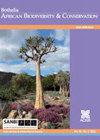Maputo Special Reserve and dung beetle conservation in the heterogeneous landscape of the Maputaland Centre of Endemism
IF 0.5
4区 生物学
Q4 PLANT SCIENCES
引用次数: 0
Abstract
Background: Maputo Special Reserve (MSR) in Mozambique lays within the Maputaland Centre of Endemism (MCE) and protects the biota of a habitat mosaic dominated by coastal dune forest and inland sand forest patches of different sizes surrounded by natural grassland. Objectives: To determine the importance of woody versus grassland vegetation for supporting endemic east coast versus widespread savanna dung beetles in the MCE in the face of increased accessibility and exploitation of woody vegetation in southern Mozambique, especially by charcoal burners.Method: We used general linear mixed models, additive partitioning of diversity and ordination to analyse species abundance and occurrence across a mosaic of three major habitats in the MSR (grassland, sand and dune forest).Results: High compositional heterogeneity was found between habitat types and study sites so that beta diversity was mostly higher than alpha diversity. Three distinct scarabaeine dung beetle assemblages defined from ordination were largely centred on the three habitat types. Out of a total of 61 species, greater numbers were associated with grassland (38) than sand (17) and dune forest (6) although abundance was greater in both dune forest and grassland than in sand forest. Biogeographical classification indicated that >40% of the species are endemic to the east coast of southern Africa with the remainder centred in adjacent savanna. Endemic east coast species were well represented in both forest (15) and grassland (11). Savanna species were better represented in grassland (27) than forest (8). Proportions of grassland species and their abundance declined across increasing patch sizes of sand forest becoming lowest in dune forest.Conclusions: Conservation of endemic, east coast dung beetle species requires the preservation of both natural grassland and sizeable patches of forest in an undisturbed habitat mosaic. As the east coastal system is relatively small in extent with the MCE widely transformed in South Africa, the MSR is an important contributor to regional conservation of endemic species.马普托特别保护区和马普托特有中心异质景观中的屎壳郎保护
背景:莫桑比克马普托特别保护区(MSR)位于马普塔兰特有中心(MCE)内,保护着由天然草地环绕的不同大小的沿海沙丘林和内陆沙林斑块为主的生境马赛克的生物群。目的:在莫桑比克南部木本植被的可及性和开发程度不断提高的情况下,确定木本植被与草地植被在支持东岸特有的和广泛分布的热带稀树草原屎壳郎方面的重要性。方法:采用一般线性混合模型、多样性加性划分和排序等方法,对MSR 3种主要生境(草地、沙地和沙丘林)的物种丰度和发生率进行了分析。结果:不同生境类型和研究地点间存在着高度的组成异质性,β多样性大多高于α多样性。根据排序定义的三种不同的金龟子屎壳郎组合主要集中在三种栖息地类型上。在61个物种中,与草地(38个)相关的物种数量多于与沙地(17个)和沙丘林(6个)相关的物种,尽管沙丘林和草地的丰度都大于与沙林相关的物种。生物地理分类表明,超过40%的物种是南部非洲东海岸特有的,其余的集中在邻近的稀树草原。东海岸特有物种在森林(15)和草地(11)中都有很好的代表性。热带稀树草原物种在草地中的代表性较好(27),而在森林中的代表性较好(8)。随着斑块大小的增加,草地物种的比例和丰度呈下降趋势,沙林在沙丘林中最低。结论:保护特有的东海岸屎壳郎物种需要在未受干扰的栖息地马赛克中保护天然草地和相当大的森林斑块。由于南非东部海岸系统面积相对较小,MCE广泛转化,因此MSR对特有物种的区域保护起着重要作用。
本文章由计算机程序翻译,如有差异,请以英文原文为准。
求助全文
约1分钟内获得全文
求助全文
来源期刊

Bothalia
生物-植物科学
CiteScore
1.70
自引率
0.00%
发文量
12
期刊介绍:
Bothalia: African Biodiversity & Conservation is published by AOSIS for the South African National Biodiversity Institute (SANBI) and aims to disseminate knowledge, information and innovative approaches that promote and enhance the wise use and management of biodiversity in order to sustain the systems and species that support and benefit the people of Africa.
The journal was previously published as Bothalia, and had served the South African botanical community since 1921. However the expanded mandate of SANBI necessitated a broader scope for the journal, and in 2014, the subtitle, African Biodiversity & Conservation was added to reflect this change.
 求助内容:
求助内容: 应助结果提醒方式:
应助结果提醒方式:


